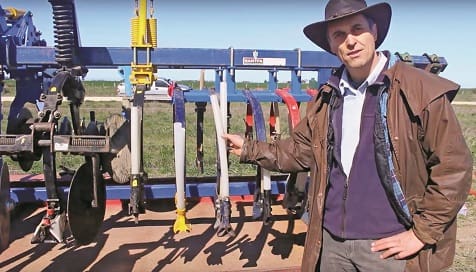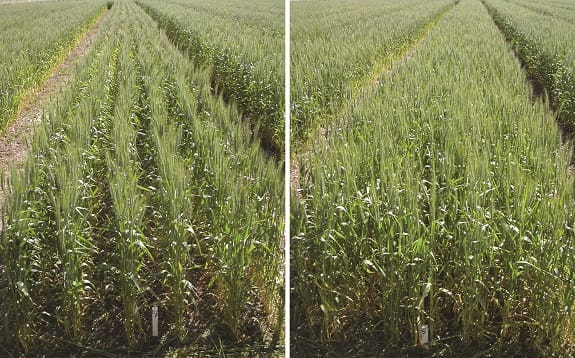
Dr Jack Desbiolles’ research favours the adoption of paired-row seeding systems as a practical way to benefit from higher seedbed utilisation. Photo: Birchip Cropping Group (BCG)
IN 2005 University of South Australia senior agricultural research engineer Jack Desbiolles led research into the effects of seedbed utilisation and seed rate on weed competition and wheat yields on a shallow grey Mallee loam near Minlaton in South Australia.
Research funded by the South Australian Grain Industry Trust Fund (SAGIT), in collaboration with the Southern Yorke Peninsula Alkaline Soils Group, centred on investigating the impact of seedbed utilisation (SBU), which quantifies the extent of the row spacing occupied by the crop.
Low SBU seeding typically makes a uniform seeding job easier to achieve but there is an increased risk for fertiliser toxicity to reduce seedling emergence, and inter-plant competition can significantly limit the yield potential in higher potential seasons.
Two wheat crop seeding rates were tested – ‘Standard’ seeding rate of 88kg/ha to establish 180 to 190 plants/m2 and ‘High’ seeding rate of 125kg/ha to establish 250 to 260 plants/m2.
Three levels of seedbed utilisation (SBU) were trialled and Marloo oats was broadcast at 40kg/ha (105 seeds/m2) and incorporated using a prickle chain on the ‘weedy’ plots to simulate weed competition.
A knife blade plus double-shoot rubber seed boot on 25-centimetre row spacing gave low (15 per cent) SBU.
The intermediate treatment was 45pc SBU using a double shoot narrow ribbon Anderson opener, also on 25cm row spacing.
Full (100pc) SBU was applied using a 20cm wide share with a 20cm reach plus Morris spreader boot set on 20cm row spacing, effectively sowing seed across the full bed area and leaving no inter-row space.
While crop seeding rate had little effect initially, the 100pc SBU had a significant effect on early weed vigour. This treatment reduced weed biomass by 16 to 20pc, and reduced weed tillering by 25 to 30pc in the early stages of growth.
SBU also had an impact on later weed growth where greater SBU proportionally reduced weed biomass by 11 to 14pc (in the 45pc SBU system) and 29 to 32pc (in the 100pc SBU system).
A 43pc reduction in weed growth was achieved using a high seeding rate combined with 100pc SBU.
Weed seed production followed similar trends, with the best results being a 38pc reduction in seed weight per weed plant using full SBU and the higher seeding rate.
Following a 289mm rainfall growing season, the full SBU seeding combined with high seed rate increased wheat grain yield by 0.43t/ha (in a weed-free environment) and 0.83t/ha (in a weedy environment), relative to the low SBU, low seed rate control.

Increasing seedbed utilisation from a common 15pc (left) to 100pc (right), especially when combined with higher seed rate, effectively suppressed weed biomass and seed production while significantly increasing crop yield.
This research confirmed the principles of crop competition and showed that paired-row systems were a practical option to help achieve greater weed competition and higher yield potential through greater seedbed utilisation.
More recently, Dr Desbiolles conducted research on different soil types in the Murrayville district (Vic) in collaboration with Mallee Sustainable Farming Inc, and with DAFF funding, comparing paired-row systems to a commonly-used single row knife point system.
In this trial, the paired-row systems gave the highest and most consistent crop establishment across a swale-dune Mallee sandy soil system, with good moisture conditions at seeding and sufficient in-crop rainfall.
The plant establishment benefits ranged from +15pc on the mid-slope and sand hill, to +20pc on the sandy stony flats, relative to a district system control, and after a dry season finish, achieved up to 0.15t/ha gain in wheat grain yield.
“These results correlate well with the earlier work done in Minlaton which measured crop yield and weed suppression benefits through increased seedbed utilisation,” he said.
“Improving crop establishment and gaining the crop competitive advantages relies on correct seeder set-up.”
In a review of seeder set-up for the GRDC Stubble Management project, Dr Desbiolles highlighted the following considerations when it comes to using paired-row systems in different situations:
- Recommended for use in marginal soil moisture conditions when seeds can be placed onto undisturbed soil moisture.
- Recommended for effective incorporation of pre-emergent herbicides (IBS) application. Crop safety is best secured using paired-row attachments closely integrated behind the opener.
- Possible use in stony soils if compatible with shallow operating depth.
- Possible use in non-wetting poor fertility soils, where seeding is at furrow tilling depth.
- Possible use under rhizoctonia pressure if coupled with best practice disease management.
- Possible use in high residue situations when coupled with good residue management strategies.
Source: WeedSmart
For more information about paired-row sowing and crop competition, visit the Weedsmart website: www.weedsmart.org.au

HAVE YOUR SAY